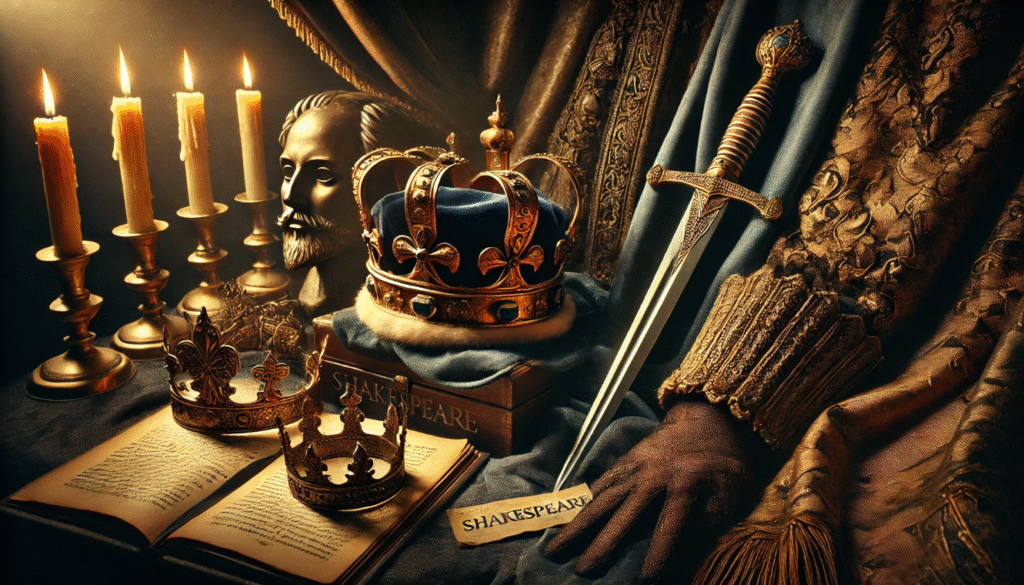
Understanding the Significance of Props and Costumes in Shakespeare’s Plays: How They Enhance Storytelling and Character Development
Have you ever wondered what makes Shakespeare’s plays so captivating, even centuries after they were first performed? 🎭 It’s not just the powerful language or timeless themes—the significance of props and costumes in Shakespeare’s plays plays a crucial role in bringing his stories to life. From the iconic dagger in Macbeth to the vibrant costumes of A Midsummer Night’s Dream, props and costumes do far more than decorate the stage—they deepen the audience’s connection with the characters and help tell the story in visually striking ways.
In this article, we’ll explore how props and costumes enhance storytelling and character development in Shakespeare’s works. By understanding their role, you’ll see how these elements elevate the emotional depth of his plays, making them resonate with audiences both past and present. Whether you’re an aspiring actor, a Shakespeare fan, or someone seeking to enrich your understanding of theatre, this article will guide you through the often-overlooked but incredibly important aspect of Shakespearean theatre. Keep reading to discover how something as simple as a costume change can completely transform a character’s journey!
Table of Contents
Toggle1. The Role of Props and Costumes in Shakespeare’s Plays
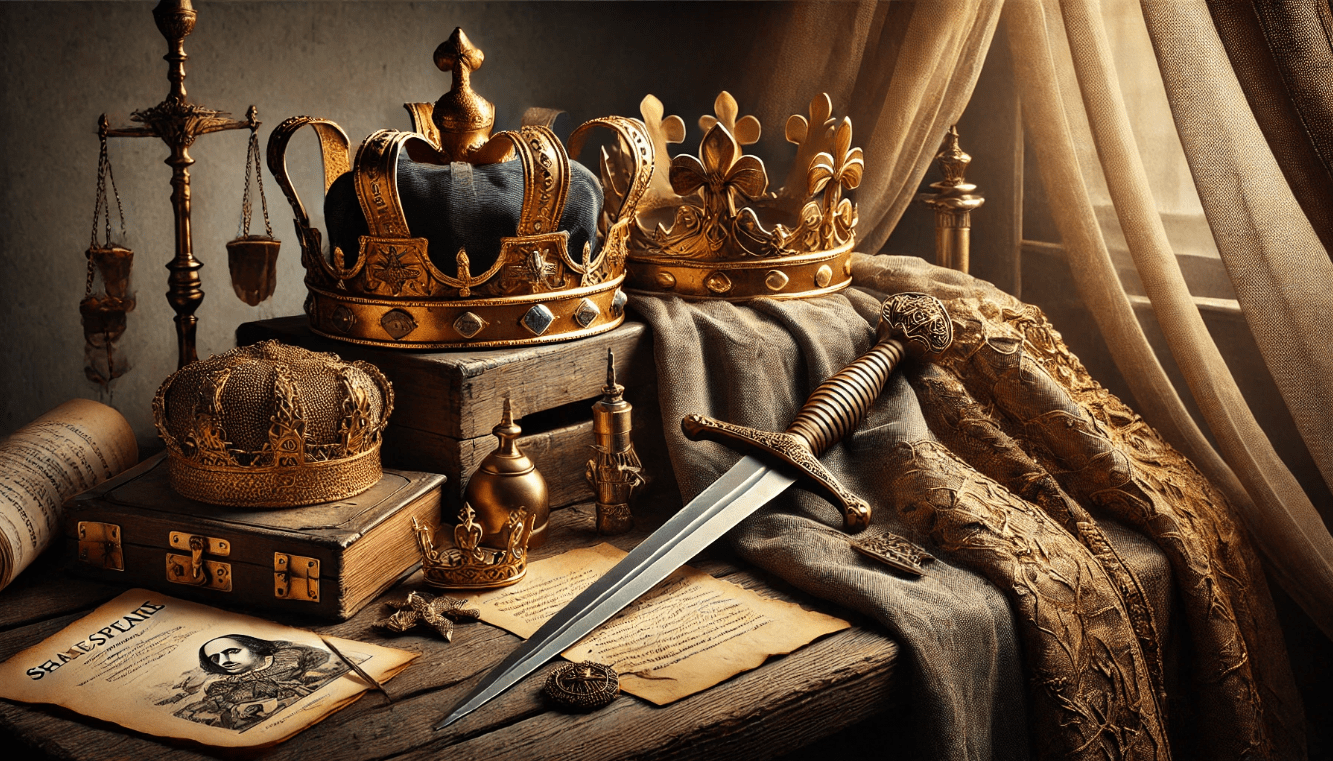
Shakespeare’s plays are timeless, not just because of their compelling plots and complex characters, but because of the significance of props and costumes in Shakespeare’s plays. These elements do more than simply set the scene—they actively enhance storytelling, convey deeper meanings, and reveal key character traits. Let’s explore how they contribute to the richness of his works. 🎭
What Are Props and Costumes in Shakespeare’s Plays?
- Props are the objects used by actors on stage—anything from a sword, a letter, or even a simple cup of wine. These physical items are essential for moving the plot forward, triggering pivotal moments, or emphasizing a character’s state of mind.
- Costumes, on the other hand, are the clothing and accessories worn by actors. In Shakespeare’s time, they not only indicated a character’s social status but also helped reveal their inner world, emotions, and transformations.
How Do Props and Costumes Support the Narrative?
Props and costumes are integral to shaping how we experience the story. They help the audience understand a character’s role and the play’s themes at a glance.
- Visual Cues: In Macbeth, for example, the famous dagger prop symbolizes Macbeth’s descent into madness, foreshadowing his dark actions. Similarly, in Hamlet, the skull prop in the “Gravedigger Scene” serves as a powerful visual metaphor for mortality and the fleeting nature of life.
- Character Identity: Shakespeare used costumes to convey much more than a character’s appearance. For instance, in Twelfth Night, Viola’s decision to dress as Cesario marks her transformation and struggle with identity. Her costume serves as a symbol of her dual life, bridging the gap between the real world and the world of disguise.
Props and Costumes: Tools for Emotional Engagement
- Emotional Depth: Costumes and props don’t just add to the visual appeal—they tap into the audience’s emotions, making the characters’ experiences more relatable. When King Lear strips off his royal garments in the storm, his costume change mirrors his emotional and psychological collapse.
- Symbolism: Many of Shakespeare’s props carry symbolic weight. In Romeo and Juliet, the letter is a prop that becomes central to the tragic miscommunication, while in Macbeth, blood-stained costumes symbolize guilt and the consequences of unchecked ambition.
2. Enhancing Character Development through Costumes
In Shakespeare’s plays, costumes do more than just define a character’s appearance—they play a pivotal role in revealing a character’s personality, emotional state, and transformation. 👗🎭 Whether it’s a crown symbolizing power or a simple cloak reflecting inner conflict, costumes are essential tools for deepening character development.
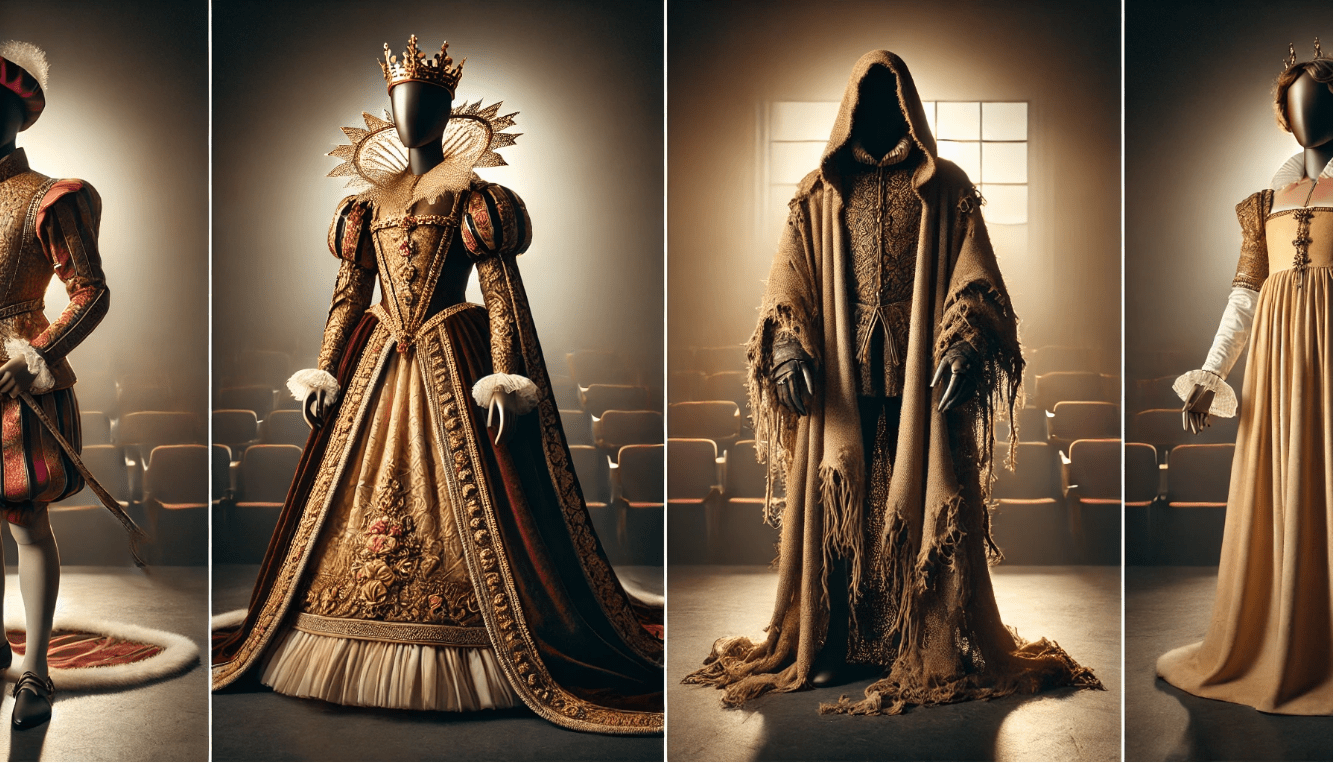
How Costumes Reflect a Character’s Personality
The first impression a character makes often comes from their costume. Shakespeare’s costume choices help to immediately establish who the character is, their status, and their role in the story.
- Example: In Macbeth, Macbeth’s royal attire at the beginning of the play reflects his high status and ambition. However, as his guilt deepens, his clothes become more disheveled, symbolizing his inner turmoil and loss of control.
- Example: In A Midsummer Night’s Dream, the fairy characters wear costumes that reflect their magical, ethereal nature, while the human characters’ costumes mirror their more grounded, real-world roles.
Costumes as a Reflection of Transformation
Shakespeare’s characters often undergo significant personal transformations, and their costumes visibly mirror these changes. From a character’s rise to power, to their descent into madness or their growth into self-awareness, costumes highlight these shifts.
- Example: In King Lear, Lear’s costume change from elaborate royal robes to a simple, ragged cloak marks his journey from power to vulnerability, symbolizing his emotional and psychological collapse.
- Example: In Twelfth Night, Viola’s transformation into Cesario, as reflected by her male costume, allows her to navigate the play’s themes of love and disguise, while also highlighting her internal conflict and growth.
Symbolic Use of Costumes to Convey Inner Conflict
In addition to marking a character’s external status or transformation, costumes also serve as visual symbols of a character’s inner struggles. Shakespeare often used costumes to reflect internal conflicts that words alone could not convey.
- Example: In Hamlet, the costume choices of the characters help signal their alignment and moral stance. Hamlet’s dark, often disheveled attire highlights his melancholy and his internal conflict as he wrestles with revenge and moral righteousness.
- Example: Lady Macbeth’s shift from regal to sleepwalking attire in Macbeth symbolizes her mental breakdown and descent into guilt and madness. Her costume’s gradual change reflects her psychological unraveling, making it easier for the audience to understand her character’s deterioration.
The Impact on Audience Connection
By using costumes in this way, Shakespeare ensures that the audience’s connection to the characters goes beyond words. A character’s costume acts as a visual cue, allowing the audience to follow their emotional and psychological journey without needing a detailed explanation.
3. How Props Help to Tell a Story in Shakespeare’s Plays
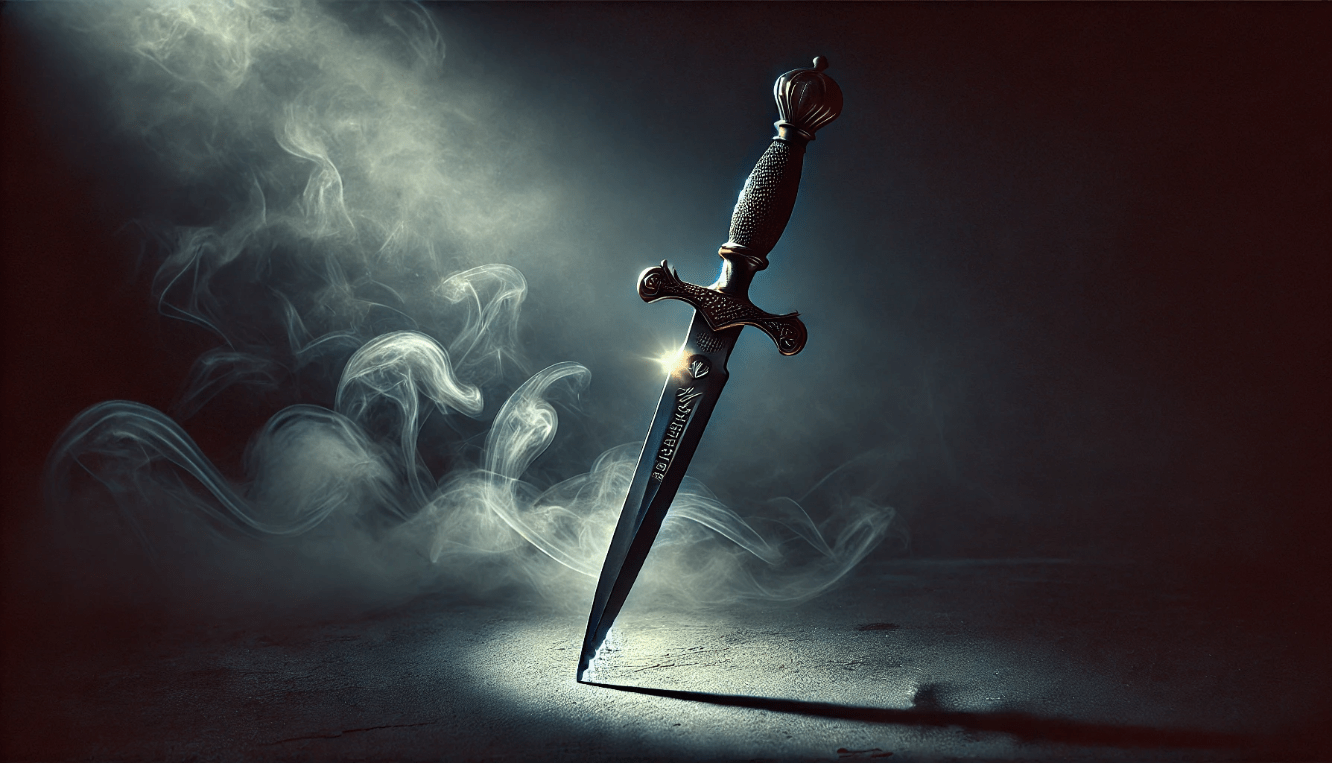
In Shakespeare’s plays, props are much more than simple stage accessories—they are essential storytelling tools that drive the narrative, deepen character development, and amplify key themes. 🎭 From a dagger to a letter, props can transform an ordinary scene into something memorable and meaningful. Let’s dive into how Shakespeare uses props to tell a more engaging story.
Props as Visual Metaphors
Many of the props in Shakespeare’s plays carry symbolic meaning, representing deeper themes and emotions. These objects are carefully chosen to act as metaphors, helping to reinforce the plot without needing words.
- Example: In Macbeth, the dagger that Macbeth imagines seeing before committing the murder symbolizes his ambition and guilt. It’s not just an object—it represents his inner turmoil and the uncontrollable forces driving him toward his downfall.
- Example: In Julius Caesar, the clock symbolizes the inevitability of Caesar’s assassination and the passage of time leading up to it. This simple prop reminds both the characters and the audience of the looming sense of doom.
Props that Drive Plot and Character Interaction
Props often serve as plot devices, triggering major plot twists, deepening relationships, or even leading to misunderstandings that move the story forward.
- Example: In Romeo and Juliet, the letter sent by Friar Lawrence is a prop that drives the tragic misunderstanding. Its failure to reach Romeo leads to the couple’s untimely death, showing how a simple object can change the entire course of the play.
- Example: In Hamlet, the poisoned cup acts as a key prop in the final scene, setting off the chain of events that leads to Hamlet’s death, making the cup a literal and symbolic tool of fate and mortality.
Props and Character Revelation
Shakespeare uses props not just as plot devices but as tools to reveal aspects of a character’s inner world. A character’s relationship with a particular prop can provide insight into their state of mind, intentions, or moral alignment.
- Example: In Othello, the handkerchief becomes a symbol of Desdemona’s fidelity and Othello’s jealousy. The constant reference to the handkerchief reflects Othello’s growing insecurity and eventual tragic jealousy.
- Example: In King Lear, the crown represents Lear’s authority and ego. Its loss and the stripping away of his power reflect his descent into madness and vulnerability.
The Symbolic Weight of Props
Props often carry weight beyond their immediate function. They act as reminders of the themes within the play, such as ambition, betrayal, or fate. Shakespeare’s careful use of props ties together the emotional and thematic elements of the play, enriching the experience for the audience.
- Example: The mirror in Macbeth could symbolize reflection—not just of Macbeth’s image, but also of his soul, showing the duality between his public persona and private guilt.
4. Thematic Role of Props and Costumes in Shakespeare’s Plays
In Shakespeare’s plays, props and costumes are not just visual elements—they are deeply intertwined with the themes and messages the playwright wishes to convey. Through these elements, Shakespeare explores complex ideas like power, betrayal, identity, and fate. 🎭✨ Let’s take a closer look at how these elements contribute to the play’s overarching themes.
Visual Representation of Themes
Props and costumes help to visually communicate the central themes of the play, often reinforcing what the audience is feeling or thinking. They act as cues that tie the audience’s emotional journey to the play’s larger message.
- Example: In King Lear, the crown is a powerful symbol of authority and the loss of power. As Lear loses his crown, it visually represents his descent into madness and the disintegration of his control over both his kingdom and his mind.
- Example: In Macbeth, the bloodstained costumes represent the moral decay and guilt that Macbeth experiences after committing murder. Blood becomes a recurring symbol, illustrating the irreversible consequences of his ambition and treachery.
Props and Costumes as Symbols of Power and Status
One of the most common themes in Shakespeare’s plays is the struggle for power. Props and costumes are used to represent characters’ social standing and ambitions, helping the audience understand the power dynamics at play.
- Example: In Julius Caesar, Caesar’s crown symbolizes the political power he seeks. His desire to wear the crown becomes a symbol of his ambition, but also of the threat to the Republic and the power struggle between him and the senators.
- Example: In The Taming of the Shrew, the costumes worn by Katherina, particularly in the final scene, reflect her shift from a rebellious daughter to a more obedient wife. Her change in attire marks the theme of submission and the reassertion of traditional gender roles.
Exploring Identity Through Costumes
Shakespeare often uses costumes to explore themes of identity and disguise, especially in plays where characters take on alternate personas. This allows characters to either escape societal expectations or confront their true selves.
- Example: In Twelfth Night, Viola’s disguise as Cesario is central to the play’s themes of love and mistaken identity. The costume reflects her ability to navigate complex emotions and societal boundaries, allowing her to explore different aspects of herself.
- Example: In A Midsummer Night’s Dream, the costumes of the fairies contrast sharply with the humans, representing the otherworldly nature of the magical realm and its separation from the mundane world.
Costumes and Props as Tools for Dramatic Irony
Sometimes, Shakespeare uses props and costumes to create dramatic irony—a device where the audience knows something that the characters do not. This adds layers to the narrative and deepens the emotional impact.
- Example: In Romeo and Juliet, the death shroud that Juliet wears in the final scene adds dramatic irony. The audience knows she is not truly dead, but Romeo, unaware, believes she is. The prop intensifies the tragedy as it marks the final moments of misunderstanding.
5. Modern-Day Interpretations of Shakespearean Costumes and Props
While Shakespeare’s plays were written in the 16th and 17th centuries, the props and costumes used in modern productions continue to evolve. Directors and designers often reinterpret these elements to reflect contemporary issues, making Shakespeare’s works feel more relatable to today’s audience. 🎭🌍
Modern Costumes: Blending Tradition with Innovation
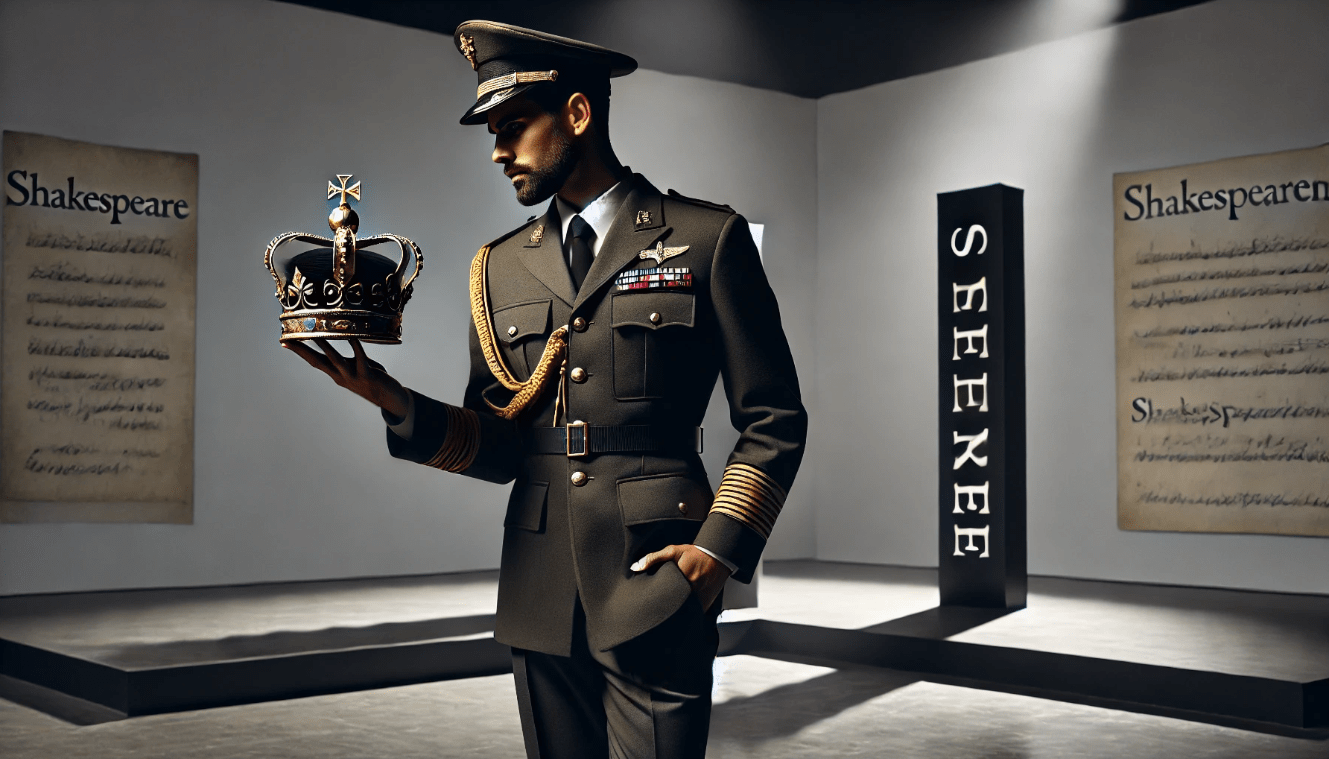
Today, costume designers often blend traditional Shakespearean attire with modern influences, adding layers of meaning to the characters and themes.
- Example: A modern production of Macbeth might dress Macbeth in military fatigues, connecting his ambition and violent actions to modern-day power struggles. This new interpretation highlights the timeless nature of Shakespeare’s themes while making them more accessible to contemporary viewers.
- Example: In Twelfth Night, a director might dress the character of Viola in contemporary clothing, reflecting modern ideas of gender fluidity and identity exploration. This costume choice emphasizes the relevance of Shakespeare’s themes in today’s world.
Props in Contemporary Productions: Minimalism vs. Symbolism
In modern productions, props are often pared down or abstracted to emphasize symbolism over realism. The minimalist approach invites the audience to focus more on the emotional depth of the play rather than the physical objects themselves.
- Example: In a minimalist production of King Lear, the crown might be a simple object like a piece of cloth or a small, unadorned ring, symbolizing the fragility of power and the insignificance of material wealth.
- Example: The dagger in Macbeth could be replaced with a simple shadow or projection, underscoring the psychological nature of Macbeth’s guilt and descent into madness, rather than focusing on a physical prop.
Reinterpreting Costumes for Cultural Relevance
Costumes in modern Shakespeare productions are often adapted to reflect current cultural and political contexts. This interpretation helps bring the timeless themes of Shakespeare’s works into conversations about modern society.
- Example: In a modern-day Romeo and Juliet, the costumes could be designed to reflect the youth culture of today—perhaps using urban, streetwear styles to make the characters’ emotions of love, rebellion, and tragedy feel more immediate and relatable.
- Example: In Julius Caesar, contemporary costumes might reflect modern-day political attire—think sharp suits or even military uniforms—to mirror current discussions about power, leadership, and the fragility of democracy.
6. The Enduring Power of Props and Costumes in Shakespeare’s Plays
Shakespeare’s plays have stood the test of time, and a large part of their enduring appeal lies in the power of props and costumes. These elements are not just decorative—they are integral to the emotional depth, themes, and storytelling that make Shakespeare’s works resonate across centuries. 🎭🌟
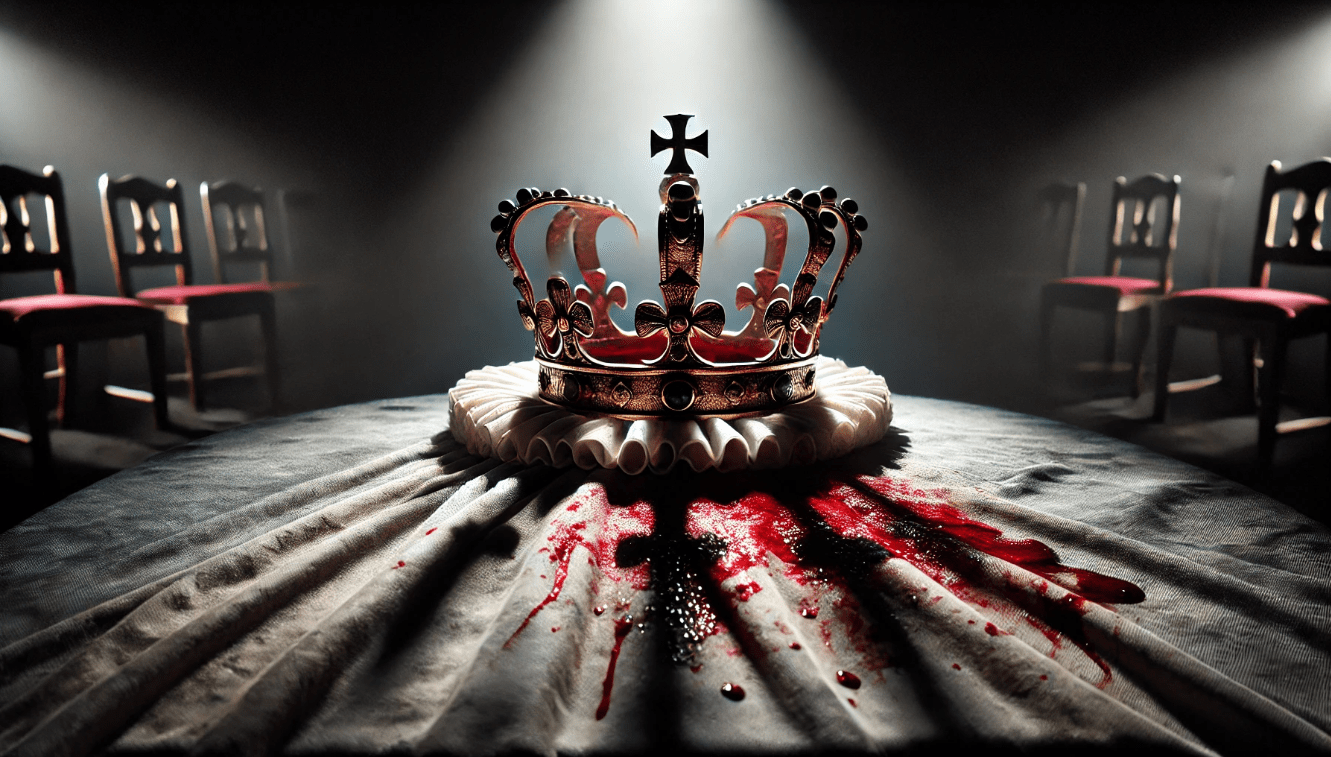
Why Props and Costumes Matter
Props and costumes are crucial tools that connect the audience to the characters and enhance the storytelling experience. They allow actors to physically embody their roles and help the audience better understand the emotions, motivations, and transformations of the characters. Through these elements, Shakespeare ensures that the plays are more than just words on a page—they become living, breathing experiences.
- Example: The blood-stained costumes in Macbeth are powerful symbols of guilt and ambition, making the audience feel the weight of Macbeth’s actions long after the scene ends.
- Example: The disguises in Twelfth Night create a layer of comedy and confusion, but also reveal deeper truths about the characters, such as their desires, fears, and inner struggles.
Universal Themes Through Timeless Design
The beauty of Shakespeare’s works is that they explore universal themes like love, power, betrayal, and identity—concepts that still resonate today. Props and costumes play a major role in conveying these timeless themes, allowing them to remain relevant across different cultures and eras.
- Example: The crown in King Lear symbolizes more than just royalty—it represents power, pride, and the fragile nature of both. This theme is just as relevant today, making the costume design just as important for modern audiences.
- Example: The letter in Romeo and Juliet represents communication, fate, and miscommunication, which are still central to modern life, making it an enduring symbol in the play.
Adapting to Changing Audiences
As times change, so too do the interpretations of Shakespeare’s plays. Modern productions often update props and costumes to connect with current cultural conversations—but the underlying power remains unchanged. The flexibility of props and costumes ensures that Shakespeare’s stories are always fresh and meaningful, regardless of when or where they are performed.
- Example: In today’s world, directors may dress characters in contemporary clothing, using modern props to reflect social issues like politics, gender, or power dynamics. The themes remain timeless, even as the setting or context shifts.
In Shakespeare’s plays, props and costumes are far more than just visual details—they are powerful storytelling tools that enrich the narrative, deepen character development, and highlight the timeless themes of the works. From symbolizing power and ambition to reflecting inner conflict and transformation, these elements help bring Shakespeare’s characters to life in ways that words alone cannot. 🎭🌟
As we’ve explored, these elements continue to evolve in modern productions, offering fresh interpretations while staying true to the core themes of the plays. Whether through symbolic props or carefully crafted costumes, these tools ensure that Shakespeare’s work remains relevant and impactful, regardless of the time period or cultural context.
Frequently Asked Questions (FAQs)
1. Why are props and costumes important in Shakespeare’s plays?
Props and costumes in Shakespeare’s plays are essential for visual storytelling. They help convey a character’s personality, emotional state, and social status, enhancing the audience’s understanding of the plot and themes. These elements also add depth to the story, making Shakespeare’s works more engaging and relatable.
2. How do costumes reflect a character’s development in Shakespeare’s plays?
Costumes in Shakespeare’s plays symbolize a character’s transformation throughout the story. For example, in Macbeth, the character’s change in attire from noble to blood-stained garments mirrors his descent into guilt and madness. Costumes act as visual cues that help the audience track a character’s emotional and psychological journey.
3. What role do props play in advancing the plot of Shakespeare’s plays?
Props serve as plot devices that drive key events in Shakespeare’s plays. For instance, the letter in Romeo and Juliet sets off the tragic misunderstanding that changes the course of the story. Props also deepen character interactions and reinforce important themes, such as power or fate.
4. How do modern interpretations of costumes and props differ from traditional ones?
Modern productions often reinterpret Shakespeare’s costumes and props to reflect contemporary issues, while still maintaining the essence of the original work. Directors might use minimalist props or modern clothing to make the themes more relatable to today’s audience, while preserving the play’s core messages.
5. Can costumes and props affect the audience's emotional connection to the play?
Yes, costumes and props are vital for creating an emotional connection between the audience and the characters. By visually representing a character’s internal struggles or status, these elements allow the audience to better understand and empathize with the character’s journey and motivations.
6. How do costumes and props enhance the themes of Shakespeare’s plays?
Costumes and props often embody the central themes of Shakespeare’s plays. For example, in King Lear, the crown represents power and authority, while its loss signifies Lear’s vulnerability and madness. These visual elements reinforce themes like ambition, love, and betrayal, making them more impactful.
7. Are props and costumes symbolic in Shakespeare’s plays?
Yes, many props and costumes in Shakespeare’s plays carry symbolic meaning. For instance, the dagger in Macbeth symbolizes Macbeth’s internal conflict and ambition. Props like these help convey complex emotions and themes, allowing the audience to experience the play on a deeper level.
8. How do props and costumes relate to Shakespeare’s cultural and historical context?
Props and costumes in Shakespeare’s plays reflect the social norms, cultural practices, and power dynamics of Elizabethan society. They help audiences understand the historical context of the play, offering a window into the customs and beliefs of the time while enhancing the authenticity of the performance.
